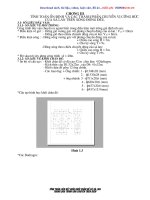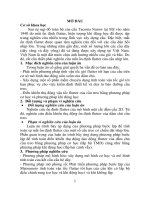Phần 10 KHÓA ĐÀO TẠO TÍNH TOÁN ỔN ĐỊNH VÀ ỨNG DỤNG TRÊN PHẦN MỀM PSSE CHO KỸ SƯ HỆ THỐNG ĐIỆN (Ngồn ngữ mô hình hóa hệ thống điện trên Phần mềm PSSE)
Bạn đang xem bản rút gọn của tài liệu. Xem và tải ngay bản đầy đủ của tài liệu tại đây (4.59 MB, 88 trang )
TRANSMISSION &
DISTRIBUTION
A Division of Global Power
POWER SYSTEM STABILITY CALCULATION TRAINING
D6
AblfStMdl
D
ay
6
-
A
ssem
bl
y o
f
S
ys
t
em
M
o
d
e
l
s
November 22, 2013Prepared by: Mohamed El Chehaly
eBook for You
OUTLINE
2
OUTLINE
• Reduced Power System
•
Non
-
Standard Models using FORTRAN
Non
Standard
Models
using
FORTRAN
• Introduction to GMB
eBook for You
3
REDUCED POWER SYSTEM
REDUCED
POWER
SYSTEM
eBook for You
Equivalents
4
REDUCED POWER SYSTEM
Equivalents
Equivalents represent a reduced network
that contains few original buses and all
boundary buses
Study system: Buses subject to detailed
study; all components are represented
explicitly
External system: Buses and branches that
connect to and influence a study system
but do not need to be represented
but
do
not
need
to
be
represented
Boundary buses: buses in the study
system that connect to external systems
system
that
connect
to
external
systems
through branches
eBook for You
Equivalents
5
REDUCED POWER SYSTEM
Equivalents
eBook for You
Steps for Equivalent Network
6
REDUCED POWER SYSTEM
Steps
for
Equivalent
Network
1. Swing buses in the study system
1. Verify that in the study system there is at least
ib
one sw
i
ng
b
us
2. If there is at least one swing bus, skip this step
3
If no swing buses assign a generator bus (code
3
.
If
no
swing
buses
,
assign
a
generator
bus
(code
2) in the study system to be a new swing bus
(code 3)
4. Solve the load flow. No changes to the power
levels should be observed
eBook for You
Steps for Equivalent Network
7
REDUCED POWER SYSTEM
Steps
for
Equivalent
Network
2. Swing buses in the external system
1. Change all the swing buses (code 3) in the
tltt tb (d2)
ex
t
erna
l
sys
t
em
t
o genera
t
or
b
uses
(
co
d
e
2)
2. Add loads on the boundary buses corresponding
to the power flows of the tie lines that connect the
to
the
power
flows
of
the
tie
lines
that
connect
the
boundary buses to the external system (DO NOT
SOLVE)
3
Di tth ti li th t tth
3
.
Di
sconnec
t
th
e
ti
e
li
nes
th
a
t
connec
t
th
e
boundary buses to the external system
eBook for You
Steps for Equivalent Network
8
REDUCED POWER SYSTEM
Steps
for
Equivalent
Network
3. Removal of External Buses
1. After disconnecting the tie lines, solve the load
fl
fl
ow
2. The load flow could not be solve due to the large
number of islanded buses
number
of
islanded
buses
3. The following message should appear:
Message for API FDNS
#### buses in island(s) without a swing bus
Use activity TREE
eBook for You
Steps for Equivalent Network
9
REDUCED POWER SYSTEM
Steps
for
Equivalent
Network
4. Islanded buses
1. Write TREE in the CLI window
2. The following message should appear:
3. To disconnect the island, write ‘1’ in the CLI
4. Repeat until all islands are disconnected
eBook for You
Steps for Equivalent Network
10
REDUCED POWER SYSTEM
Steps
for
Equivalent
Network
5
Sh t
iitll
5
.
Sh
or
t
-c
i
rcu
it
l
eve
l
s
1. Determine the short-circuit levels (three-phase
and single
-
line
-
to
-
ground) at the boundary buses
and
single
line
to
ground)
at
the
boundary
buses
in the original system both in physical output
(MVA and A) and in per unit (pu) and in polar
coordinates
coordinates
2. Add a dummy generator at the boundary bus of
the modified s
y
stem with zero
p
ower and a
yp
calculated impedance to match the original short-
circuit level
eBook for You
Steps for Equivalent Network
11
REDUCED POWER SYSTEM
Steps
for
Equivalent
Network
5. Short-circuit levels
3. Verify that the error difference between the
original and the new short-circuit levels does not
exceed 5%
exceed
5%
4. In the original system, disconnect all lines with
the boundar
y
buses exce
p
t for the ties with the
yp
external system and calculate the short-circuit
level in MVA
5
In the reduced system change the rating of the
5
.
In
the
reduced
system
,
change
the
rating
of
the
equivalent generator to the value found in step 4
6. Chan
g
e the im
p
edances of the
g
enerator to the
gp g
new machine base
eBook for You
Steps for Equivalent Network
12
REDUCED POWER SYSTEM
Steps
for
Equivalent
Network
6
Pflithtdt
6
.
P
ower
fl
ows
i
n
th
e s
t
u
d
y sys
t
em
1. Verify that the power flows within the study
system match the original power flows
system
match
the
original
power
flows
2. If there is a large difference, add loads that
compensate this difference
3. Check that the power flows should be within 5%
of the original ones found in the complete system
4
Voltages and angles at all buses in the equivalent
4
.
Voltages
and
angles
at
all
buses
in
the
equivalent
system should match the ones in the complete
system
eBook for You
Steps for Equivalent Network
13
REDUCED POWER SYSTEM
Steps
for
Equivalent
Network
7
Cltdilttk
7
.
C
omp
l
e
t
e
d
equ
i
va
l
en
t
ne
t
wor
k
1. The equivalent network is now completed
2
The buses of the external systems can be
2
.
The
buses
of
the
external
systems
can
be
deleted
3. D
y
namic simulation can now be carried out on
y
the equivalent system
4. The behaviour of the external systems in the
dynamic simulation is neglected
dynamic
simulation
is
neglected
eBook for You
Vietnamese Power System
14
REDUCED POWER SYSTEM
Vietnamese
Power
System
Vietnamese Map
Pl ik
External System
Pl
e
ik
u
Study System
eBook for You
Vietnamese Power System
15
REDUCED POWER SYSTEM
Vietnamese
Power
System
500 kV system
Boundary bus
External System
Boundary
bus
Study System
eBook for You
Vietnamese Power System
16
REDUCED POWER SYSTEM
Vietnamese
Power
System
220 kV system
External System
Study System
eBook for You
Vietnamese Power System
17
REDUCED POWER SYSTEM
Vietnamese
Power
System
1. Swing buses in the study system
No swing buses were found in the study system
The only swing bus connected to it is HBINH_H1
(bus 28610) located in the North
A new generator bus is chosen to be an
A
new
generator
bus
is
chosen
to
be
an
additional swing bus: PMY_1_S4 (bus 52040)
Solve the load flow
eBook for You
Vietnamese Power System
18
REDUCED POWER SYSTEM
Vietnamese
Power
System
2. Swing buses in the external system
Change all the other swing buses to generator
buses
Add loads at the boundary bus corresponding to
the flows in the tie lines
eBook for You
Vietnamese Power System
19
REDUCED POWER SYSTEM
Vietnamese
Power
System
3. Removal of External Buses
Solve and the following message appears
eBook for You
Vietnamese Power System
20
REDUCED POWER SYSTEM
Vietnamese
Power
System
4. Islanded buses
Write TREE in the CLI
Wit 1t di t
W
r
it
e
1
t
o
di
sconnec
t
eBook for You
Vietnamese Power System
21
REDUCED POWER SYSTEM
Vietnamese
Power
System
4. Islanded buses
Repeat for all islands
Repeat
for
all
islands
eBook for You
Vietnamese Power System
22
REDUCED POWER SYSTEM
Vietnamese
Power
System
5
Sh t
iitll
5
.
Sh
or
t
-c
i
rcu
it
l
eve
l
s
The short-circuit level at the boundary bus
PLEIKU (bus 3300) in the original system is:
PLEIKU
(bus
3300)
in
the
original
system
is:
eBook for You
Vietnamese Power System
23
REDUCED POWER SYSTEM
Vietnamese
Power
System
5
Sh t
iitll
5
.
Sh
or
t
-c
i
rcu
it
l
eve
l
s
The short-circuit level at the boundary bus
PLEIKU (bus 3300) in the reduced system is:
PLEIKU
(bus
3300)
in
the
reduced
system
is:
eBook for You
Vietnamese Power System
24
REDUCED POWER SYSTEM
Vietnamese
Power
System
5
Sh t
iitll
5
.
Sh
or
t
-c
i
rcu
it
l
eve
l
s
In order to get the impedance of the equivalent
machine the following equations have to be
machine
,
the
following
equations
have
to
be
solved for all sequence impedances
111
The result is
equivalentcompletemachine
X
X
X
X
puX
pu
X
04389
0
02525.0
02518.0
2
1
Base: 100 MVA
pu
X
04389
.
0
0
eBook for You
Vietnamese Power System
25
REDUCED POWER SYSTEM
Vietnamese
Power
System
5
Sh t
iitll
5
.
Sh
or
t
-c
i
rcu
it
l
eve
l
s
In order to get the impedance of the equivalent
machine the following equations have to be
machine
,
the
following
equations
have
to
be
solved for all sequence impedances
111
The result is
equivalentcompletemachine
X
X
X
X
puX
pu
X
04389
0
02525.0
02518.0
2
1
Base: 100 MVA
pu
X
04389
.
0
0
eBook for You









